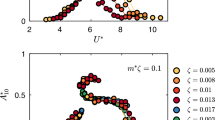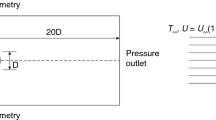Abstract
We present a semi-hollow body as an effective strategy to increase the driving force for vortex-induced vibrations (VIVs) of a circular cylinder. The hollow-body concept is evaluated numerically at Reynolds number Re = 200 and in a range of reduced velocity 3 ≤ Ured ≤ 8 with a mass-spring system released to vibrate in the transverse direction. Our numerical solutions reveal that, compared with solid-cylinder counterparts, the net transverse force is increased significantly through the semi-hollow body. The transverse force acting on the inner surface is found to be developed as a consequence of semi-confined flows driven by the cylinder oscillation. Furthermore, it is shown that the inner force has a phase difference with respect to the force acting on the outer surface. Based on a systematic force analysis, the appreciable increase in the transverse force is attributed to the constructive interference between the inner and outer forces.
Similar content being viewed by others
Abbreviations
- t :
-
Time
- m :
-
Mass
- k :
-
Spring stiffness
- c :
-
Damping coefficient
- P i :
-
Position vector
- p :
-
Pressure
- V :
-
Kinematic viscosity
- ω:
-
Vorticity
- f :
-
Oscillation frequency
- f n :
-
Natural frequency
- Re :
-
Reynolds number
- St :
-
Strouhal number
- U red :
-
Reduced velocity
- M red :
-
Reduced mass
- C D :
-
Drag coefficient
- C L :
-
Lift coefficient
- C p :
-
Pressure coefficient
References
C. H. K. Williamson and R. Govardhan, Vortex-induced vibrations, Annu. Rev. Fluid Mech., 36 (2004) 413–455.
M. J. Khan, X. I. Bhuyan, X. T. Iqbal and J. E. Quaicoe, Hydrokinetic energy conversion systems and assessment of horizontal and vertical axis turbines for river and tidal applications: A technology status review, Appl. Energy, 86 (2009) 1823–1835.
C. H. K. Williamson and A. Roshko, Vortex formation in the wake of an oscillating cylinder, J. Fluids Struct., 2 (1988) 355–381.
A. Khalak and C. H. K. Williamson, Motions, forces and mode transitions in vortex-induced vibrations at low mass and damping, J. Fluids Struct., 13 (1999) 813–851.
P. W. Bearman, Vortex shedding from oscillating bluff bodies, Ann. Rev. Fluid Mech., 16 (1984) 195–222.
P. W. Bearman, Circular cylinder wakes and vortex-induced vibrations, J. Fluids Struct., 27 (2011) 648–658.
O. M. Griffin, Vortex-shedding from bluff bodies in a shear flow: A review, J. Fluids Engng.: Trans. ASME, 107 (1985) 298–306.
T. Sarpkaya, A critical review of the intrinsic nature of vortex-induced vibrations, J. Fluids Struct., 19 (2004) 389–447.
H. Choi, X. P. Jeon and J. Kim, Control of flow over a bluff body, Annu. Rev. Fluid Mech., 40 (2008) 113–139.
H. Baek and G. E. Karniadakis, Suppressing vortex-induced vibrations via passive means, J. Fluids Struct., 25 (2009) 848–866.
M. Sánchez-Sanz and A. Velazquez, Passive control of vortex induced vibration in internal flow using body shape, J. Fluids Struct., 27 (2011) 976–985.
Y. Yu, X. Xie, X. Yan, X. Constantinides, X. Oakley and G. E. Karniadakis, Suppression of vortex-induced vibrations by fairings: A numerical study, J. Fluids Struct., 54 (2015) 679–700.
Y. Z. Law and R. K. Jaiman, Passive control of vortex-induced vibration by spanwise grooves, J. Fluids Struct., 83 (2018) 1–26.
A. Laneville and M. Matsumoto, Galloping of a cylinder fitted with a thin protrusion, 13th Int. Conf. Wind Eng., Amsterdam (2011).
L. Ding, X. Zhang, X. Wu, X. Mao and D. Jiang, Flow induced motion and energy harvesting of bluff bodies with different cross sections, Energy Convers. Manag., 91 (2015) 416–426.
G. M. Hu, X. T. Tse, X. Wei, X. Naseer, X. Abdelkefi and K. C. S. Kwok, Experimental investigation on the efficiency of circular cylinder-based wind energy harvester with different rod-shaped attachments, Appl. Energy, 226 (2018) 682–689.
J. H. Ferziger and M. Perić, Computational Methods for Fluid Dynamics, Springer (1996).
C. Liu, X. Zheng and C. H. Sung, Preconditioned multigrid methods for unsteady incompressible flows, J. Comput. Phys., 139 (1998) 35–57.
T. Farrant, X. Tan and W. G. Price, A cell boundary element method applied to laminar vortex-shedding from arrays of cylinders in various arrangement, J. Fluids Struct., 14 (2000) 375–402.
J. R. Meneghini, X. Saltara, X. L. R. Siqueira and J. A. Ferrari, Numerical simulation of flow interference between two circular cylinders in tandem and side-by-side arrangements, J. Fluids Struct., 15 (2001) 327–350.
K. Lam, X. Q. Gong and R. M. C. So, Numerical simulation of cross-flow around four cylinders in an in-line square configuration, J. Fluids Struct., 24 (2008) 34–57.
J. C. Owen, X. W. Bearman and A. A. Szewczyk, Passive control of VIV with drag reduction, J. Fluids Struct., 15 (2001) 597–605.
I. Borazjani and F. Sotiropoulos, Vortex-induced vibrations of two cylinders in tandem arrangement in the proximity-wake interference region, J. Fluid Mech., 621 (2009) 321–364.
M. Shaaban and A. Mohany, Flow-induced vibration of three unevenly spaced in-line cylinders in cross-flow, Journal of Fluids and Structures, 76 (2018) 367–383.
S. Mittal and V. Kumar, Finite element study of vortex-induced cross-flow and in-line oscillations of a circular cylinder at low Reynolds numbers, Int. J. Numer. Meth. Fluids, 31 (1999) 1087–1120.
A. Khalak and C. H. K. Williamson, Fluid forces and dynamics of a hydroelastic structure with very low mass and damping, J. Fluids Struct., 11 (1997) 973–982.
S. Mittal and V. Kumar, Flow-induced oscillations of two cylinders in tandem and staggered arrangements, J. Fluids Struct., 15 (2001) 717–736.
O. M. Griffin, Flow near self-excited and forced vibrating circular cylinders, J. Engng. Industry: Trans. ASME B, 94 (1972) 539–547.
H. M. Blackburn and R. D. Henderson, A study of two-dimensional flow past an oscillating cylinder, J. Fluid Mech., 385 (1999) 255–286.
H. Al-Jamal and C. Dalton, Vortex induced vibrations using Large Eddy Simulation at a moderate Reynolds number, J. Fluids Struct., 19 (2004) 73–92.
Acknowledgments
This work was supported by the National Research Foundation of Korea (NRF) grants funded by the Korean government (Ministry of Science, ICT, and Future Planning) (No. 2017R1 D1A1B03032117).
Author information
Authors and Affiliations
Corresponding author
Additional information
Recommended by Editor Yang Na
Sungmin Ryu is a faculty member of the Department of Mechanical Engineering, Incheon National University. He received his Ph.D. in Mechanical Engineering from Stanford University. His research interests include fluid-structure interaction (FSI) and turbulence modeling.
Seungmin Kang has been a Ph.D. candidate in Department of Mechanical Engineering at Hanyang University, Seoul, Korea. His research interests include computational fluid dynamics, fluid-structure interaction, and multiphase flows.
Rights and permissions
About this article
Cite this article
Kang, S., Ryu, S. Passive increase in driving force in vortex-induced vibration of a semi-hollow cylinder for Reynolds number 200. J Mech Sci Technol 34, 2435–2442 (2020). https://doi.org/10.1007/s12206-020-0519-3
Received:
Revised:
Accepted:
Published:
Issue Date:
DOI: https://doi.org/10.1007/s12206-020-0519-3




